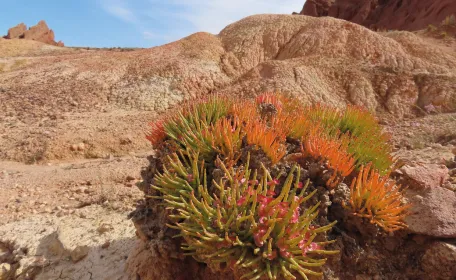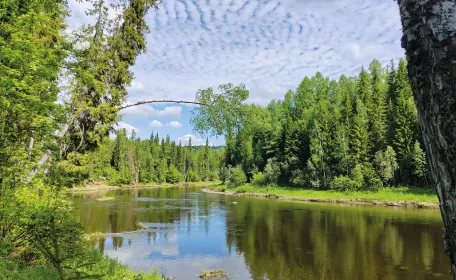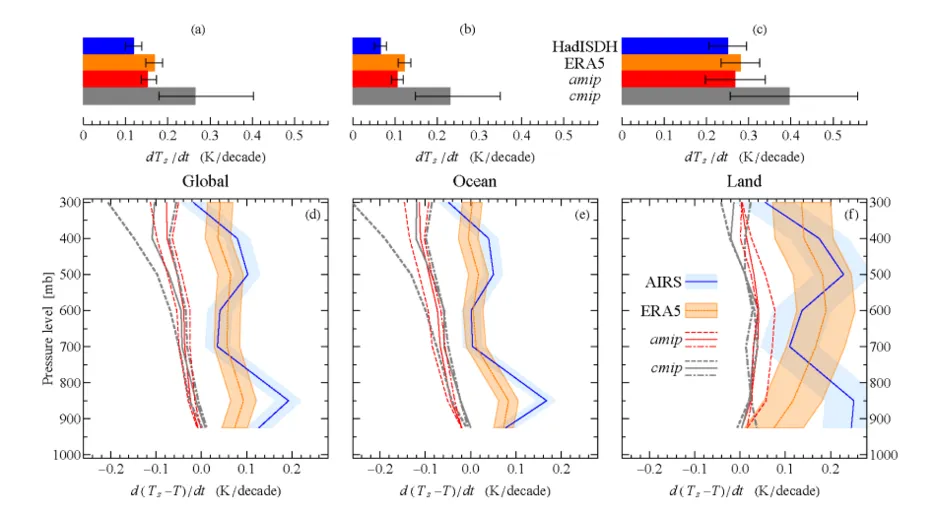In Focus:
Green Oceans of the Blue Planet
Not only are forests more complex than is commonly realized, they also do more. Their active role in transporting moisture thousands of kilometers inland from oceans, argues Anastassia Makarieva of the Petersburg Nuclear Physics Institute, should not be overlooked in studies of global climate change. This is one focus of her TUM-IAS collaboration with TUM Professor Anja Rammig, as discussed in an interview.

Petersburg-based physicist Anastassia Makarieva is a pioneer in examining large-scale effects of the interactions between living things and the environment. She focuses on phenomena such as long-distance moisture transport, chiefly within the framework of theoretical concepts known as biotic regulation and the biotic pump. An Anna Boyksen Fellowship from the TUM-IAS has facilitated her collaboration with Anja Rammig, Professor of Land Surface-Atmosphere Interactions at TUM. Science journalist Patrick Regan discussed this research with them in an interview.
Q: As I understand it, Anastassia, you have been studying mechanisms through which major tropical and boreal forest belts can play a role in both global climate trends and events such as hurricanes and droughts. You describe a biotic pump, for example, by which forests draw water vapor far inland from the oceans and thus help to preserve the conditions for life. Could you explain this with an example?

Makarieva: An important development we made during my time with the TUM-IAS, published in Global Change Biology, is that we have now identified two regimes: one where the biotic pump works, so plant transpiration increases atmospheric moisture transport and moisture import; and another one we call the dry regime, when plants transpire but there is no condensation, and hence the biotic pump dynamics is not initiated. In this case we can see that with increasing transpiration we have decreasing atmospheric moisture import to the considered area from the surrounding regions, including the ocean. So we have two regimes with distinct reactions to increased plant transpiration. This means there is a tipping point in the functioning of the ecosystem, and if, for example, by logging, we disturb it in such a way that it gets drier and drier, at a certain point this can lead to a self-destructive loop wherein the ecosystem won’t be able to contribute to sustaining its own water cycle.
Conversely, we could help the ecosystem. When we begin to restore a dry place, for example initially with irrigation, there is hope that it will pass through this tipping point again and become self-sustainable. This is an important thing that we had not explicated before. We used data for the Amazon, for the wet regime, and for China, where there are examples of both dry and wet regimes.
Q: How does this mechanism affect or involve atmospheric currents, the so-called flying rivers?
Makarieva: I can explain on the example of the Amazon. Here this effect was described independently, not connected to the biotic pump, by other researchers. When the forest, after the end of the dry season, begins to transpire, the atmosphere moistens and there is condensation, and the air begins to move from the Atlantic Ocean to the forest. So forest transpiration triggers condensation over the forest, and it leads to the appearance of the air motion from ocean to land. This occurs two months earlier than the geophysical rain band, which is the Intertropical Convergence Zone. The question is, what is the physics of that? What we’re saying is that it is because of the pressure drop from condensation, from precipitation, basically there is less atmospheric mass, and when it occurs on a very big scale, like over 1,000 kilometers, this facilitates air motion.
Q: If there is strong evidence that the biotic pump affects both weather and climate, why isn’t it taken into consideration in global climate models or policy discussions?
Rammig: The main critique that I always hear is that this effect is not large enough that it would really make such big air masses move. This is the main critique you got, right?
Makarieva: It is difficult to say what the main critique is. As a recent independent study puts it, the biotic pump “has been heavily contested, yet seemingly without a definitive resolution.” Specifically for the Amazon, we did show that our prediction fits the data. This was published in 2014. The data are not very precise, but to the precision that we have, they fit with our expectations. It is not a weak effect. It is very sizeable.
We are always doing parallel research on tropical storms. Forests are incredibly complex. You can’t easily pinpoint what’s going on there. But tropical storms are physical systems, and fairly simple compared to living systems. We can point out what happened there, and if it worked there, it should work in the forest as well.
Rapid intensification of tropical storms is a very big problem for meteorological science. It is recognized that this is very poorly predicted. So there is a weak tropical storm, and suddenly there is a Category 5 hurricane. Sometimes it goes very rapidly, and the hurricane models fail to predict it. We were the first to point out that this rate of rapid intensification, how fast the pressure falls, is closely related to the precipitation in the storm center. Precipitation removes mass, so there is less and less air pressure, and this coincides with the maximum rate of intensification. This was not known. Nobody even looked at this, from that side. If it is so, how can people claim the effect is unimportant?
Q: One way you’ve described biotic regulation is “the key role of natural ecosystems in stabilizing a life-favorable environment.” That sounds like something that should be considered in confronting the global climate crisis and the issues it raises – including impacts, adaptation, and vulnerabilities as well as mitigation. Are you concerned that faulty assumptions or incomplete models could lead to counterproductive policies?

Makarieva: Yes, and I can give you a very current example. We all know that 2023 and 2024 were abnormally warm, such that mainstream climate science can’t explain it. As leading climatologists confessed, we are on uncharted ground. We don’t know what happened, why there was this uptick of temperature. Some claim that they need more resources to get real-time data to understand what’s going on. But when there is this recognition from the climate modeling community that none of the models have predicted that this is even possible, now is a good moment to look at the alternatives. Among potential causes of anomalous warming, some scientists hinted at teleconnections, oceanic and atmospheric currents. So something in the oceanic and atmospheric currents could represent a tipping point, which could be behind this abrupt extra warmth.
Now we know that during the same time, the Amazon has been suffering one of the worst droughts, if not the worst, in history. So it is precisely long-distance moisture transport that was disrupted. On nearly a global scale, in a critically important climatic region – the tropics. So it could be that this was the cause, piled on top of the regular greenhouse gas accumulation.
If you look at global climate models, and how they describe the Amazon moisture transport, it is all parameterized. What is parameterization? When a modeler applies his or her own ideas, for example about how the atmosphere should produce rain, this is introduced manually into the model after fitting to observations. In the case of the Amazon, if you remove convective parameterization, the dynamics of many global climate models are such that they don’t transport moisture to the continent at all. This is a well-known fact. So basically all the transport into the Amazon in the models is manually fitted to the observations, which means that the capacity to predict things is severely limited. Parameterizations fitted to data under normal conditions may go totally wrong when the Amazon forest becomes sick enough.
So we have unexplained warming, terrible drought in the Amazon, and severely limited predictive value of the models with respect to long-distance moisture transport. It is a good time, a very good moment, to look seriously at alternative explanations – precisely, that the forest itself regulates moisture transport, and that when it’s disturbed beyond a threshold by human overexploitation, we can see all these consequences.
Q: To what extent is the biosphere part of the climate models?
Rammig: Current Earth system models that simulate climate change have integrated land surface models. They simulate the feedbacks from the land surface, the carbon cycle, and also the water cycle. Often, the feedbacks are very coarsely represented. Earth system models are large and complex, often constrained by the runtime and available computational power, and it has always been necessary to make a lot of simplifications. The modelers needed to be pragmatic. Often, Earth system modelers have their background in atmospheric sciences, so there is ususally more emphasis on the development of atmospheric processes.
Q: Until Suki Manabe and others linked the atmosphere to the oceans.
Rammig: Exactly. And then came the link to the land surface, and then came the link to the carbon cycle. Every process you introduce causes some feedbacks in the Earth system, which requires the modelers to readjust other parameters and try to make the model stable again.
I’m working only with land surface modeling. We have now developed a new version of our model where we simulate in more detail how the plants take up the water from the soil and pump it through their system, through the stem, and then release it to the atmosphere. Trees have different strategies, and we have implemented this now in the model. You have to adjust all the other processes, like how evapotranspiration and carbon uptake are simulated, and it often makes the model unstable. In the end, the goal is to reproduce the observed pattern. And of course, as Anastassia says, you can always tune parameters so that you can reproduce the observed patterns, but it can also be for the wrong reasons.
We can now show, with our land surface model, that we can simulate drought effects in the Amazon and show that this has a strong impact on tree growth and tree mortality. So we now can reproduce observations that other models without hydraulic processes cannot.
Implementing this into the Earth system model would be even more complicated. And there are many processes that are not well understood. And if you wanted to implement this biotic pump theory, you might have to change the basic principles of the models.

Makarieva: Yes, this is challenging. But think about this concept of Spaceship Earth. When it comes to a real spaceship, engineers always say to plan for the worst-case scenario. And in industries like information technology, it’s common for companies to pay for research that exposes vulnerabilities. My view is that the climate community should endorse and welcome disruptions instead of always defending the current understanding.
Rammig: I want to add something. You mentioned adaptation and mitigation of climate change. This relates to the paper Anastassia mentioned earlier, which we wrote together. Currently, it is assumed that afforestation is a very efficient method to mitigate climate change, and now everyone is planting forests everywhere. I think it is very important to keep in mind that a forest is not just some machine that sucks up a lot of carbon. There are many other feedbacks, especially with regard to the water cycle, that are not at all considered in these afforestation efforts. There is much more to consider when you do afforestation or reforestation projects. There are many more processes that you are not aware of – which are not intuitive and straightforward – that should be considered.
Q: Could you elaborate?
Makarieva: This was the motivation behind our second paper, published in Frontiers of Forests and Global Change. This received quite a bit of resonance. We objected to the idea that boreal forests are bad for climate because they make the surface dark and have a small albedo. That idea could lead to dangerous practices. We proposed a moratorium on exploiting old-growth forests, on a global scale. It was picked up by American scientists, and 100 of them signed it and made an appeal to then-President Biden.
When you put boreal forests into the climate models, it gets warmer because they absorb more sunlight. So you might think that doing away with the forests gets the Earth cooler. So basically even though they store carbon, it is better without them – according to global climate models. What we wanted to call attention to is that transpiration, besides moistening the atmosphere and influencing the dynamics of circulation, also has an important function of cooling the surface. According to the models, it doesn’t lead to global cooling, but it could – and we suggested how it could.
You see, there isn’t transpiration or evaporation without precipitation. There is a very small amount of moisture in the atmosphere. Everything that goes in goes out. They are always matched, to a very high precision.
So what’s going on when we have a transpiring forest? Solar energy is absorbed at the surface, and it is not converted to heat. It is absorbed and spent on evaporation, tearing the molecules from the water phase. Then this moist air goes up, and then this latent heat is released, first to thermal energy of molecules, and then from this higher level it ultimately radiates to space. This solar energy is converted to heat, high in the atmosphere, and goes to space, leaving all the greenhouse absorbers beneath. So basically this radiation escapes the greenhouse gases, and thus the planet is cooler.
Now suppose you turn off the transpiration. Now all the solar energy is turned to heat at the surface, sensible or just radiation – sensible heat also dissipates close to the surface – and so all this radiation now goes through the greenhouse gases and is trapped and partially returns to the surface. So the greenhouse effect increases, and the planet warms as a whole. We calculated that this can be quite significant.
We identified a physically plausible mechanism that shows that the models can be incorrect. And this could lead to a reconsideration of the role of all forests, including boreal. We actually showed that this can be pronounced, and that you can see it in observations and can discriminate between warming solely due to greenhouse gases and warming due to reduced transpiration. The problem will be in trends in temperature at different altitudes. Speaking simply, if you remove heat from an upper level and put it to the ground, at the ground the temperature will grow faster than at the height from which you removed the heat. So we have these different rates of temperature trend at different heights. This is shown in observations, and this is another thing the models can’t explain. We have shown that if you have a reduction in transpiration, it should have this effect.
It is a profound revision of our understanding of global warming. I’ve always wanted to do something real to save forests. This Frontiers paper, “Reappraisal of the role of natural forests,” is the most real thing that could work to save these forests – if it gains wider traction.

© 2023 Makarieva, Nefiodov, Rammig & Nobre (Creative Commons Attribution License CC BY.
Q: Both of you, in addition to your work on physical analysis and ecosystem modeling, spend a lot of time in forests. Could I ask you to talk about how that experience affects you and influences your scientific work?
Rammig: We held a conference here, on Embracing Nature’s Complexity. When you work in the forest, you get a feel for it. It sets a very high standard for complexity. Some people, with good intentions, propose technical solutions for ecological problems. But it is unproven that we can replace even a single element of the system, say, by inventing an artificial bee. When we look at the system as a whole, its complexity is totally beyond our capacity. If we look at this mechanism of climate regulation, we won’t be able, ever, to make a technological substitute.
Makarieva: I do think that implicitly many people can’t accept that forests have a greater and far more complex role than just being there as carbon sinks. We have embraced artificial intelligence and supercomputers, yet when faced with the supercomputer of life itself, we reduce it to simple chemical reactions – CO₂, carbohydrate production – little more. This is a dangerous perspective.
Rammig: I agree. It is very important to acknowledge this as a revolutionary idea. The forests are not just there because they have been planted by humans. The old-grown forests are there because of a long evolutionary pathway that brought them there. I would divide all people into those who know what complexity is and those who have never really faced it. The complexity of life is absolutely unprecedented, and we need to keep it intact as much as we can.
Q: This is easier said than done, with a variety of pressures on not only heavily exploited forests, but also on areas that remain in something more like the natural state created by evolution. How can you put all this into perspective?
Rammig: The Amazon forest always gets a lot of attention. I realize this because I am working on these forests for quite some time now, and there is a lot of interest, often in the news, and I get requests from journalists, from TV, and so on. The boreal forests don’t have this standing somehow. This makes it more difficult to highlight that this is also an old-grown, huge forest biome, one of the largest existing forest biomes besides the Amazon rainforest, but it doesn’t have these lobbies, so to say. This makes it even more difficult to communicate that this is also a very important forest system that needs to be saved.
And it doesn’t make any sense to cut it down and then restore it, because then you lose all the functions that this old-grown forest has. It will never come back to this state. This is also something I learned from Anastassia. I always was aware of it, and I always wanted to work in the boreal forests – from the beginning of my research, I was much more focused on the cold forests than the tropical ones. Anastassia explained to me that Russia is still relying on the natural resources of the forest, to cut it down and sell it. This also happens in the Amazon, but I think this is very important to consider, that there is not the same kind of public and institutional support for the boreal forests that there is for the Amazon.
Q: Like the status of endangered animals that aren’t seen as charismatic?
Rammig: Exactly.
“The complexity of life is absolutely unprecedented, and we need to keep it intact as much as we can.”
Anja Rammig
Q: Haven’t you written that cutting down forests in Europe could affect agriculture as far away as China?
Makarieva: Not just Europe, but this entire Eurasian forest belt. It’s 7,000 kilometers across. There are studies, by other researchers, showing that indeed China receives a lot of moisture through this moisture recycling and also the biotic pump, which in the boreal forest takes a different form than in the tropics. There moisture is transported in the form of atmospheric vortices, and so the intensity of precipitation is what matters.
Our message to China is that by cutting old-growth forests in Siberia they disrupt the moisture flow to China. Then they plant trees in China to stop aridity. However, plantations are no substitute for the vast natural forests that have evolved the capacity to stabilize the terrestrial water cycle. What is actually needed to stabilize the Eurasian water cycle is investment into highly productive plantations somewhere close to cities, to satisfy economic demand, and simultaneously setting aside massive territories with natural old-growth forests totally exempted from exploitation, to stabilize the climate and the water cycle. It is totally doable.
What is optimistic about the strategy of relying on the biosphere to solve global change problems is that our economy no longer critically depends on the destruction of the biosphere, as it used to depend say a couple of centuries ago.
Rammig: But it actually is becoming more and more the basis of economy, saying that forests are important for mitigating climate change. This is something we have in Europe now. There are several different kinds of pressures on forests: They should store carbon; they should also be there for construction; wood can now be used as a substrate for many other materials. Because it is acknowledged now that forests are good for the climate.
Makarieva: But in which sense? In North America now they have forests that approach old-growth conditions, that have recovered from disturbances 100 to 150 years ago, but these forests are now logged for pellets and transported to Europe for a greener economy.
Rammig: This is exactly what I mean. We can stop deforestation, but our economy has started to change a bit to get away from fossil fuel burning, and the role of wood is acknowledged more – and then these strange kinds of things happen. This could again threaten old-growth forests, because there you have all this wood. You can easily cut it down and sell fuel pellets somewhere where you can earn a lot of money, and it’s “green.”
Makarieva: And it’s subsidized. So it’s becoming green to destroy forests. Words fail me, how destructive this is. Cutting down forests for pellets is the first thing that should be stopped.
Q: So is this where there’s a role for industrial forestry, to grow trees specifically for such purposes?
Rammig: No, that’s not straightforward either. Where should you do that? In Europe, we now have this credo of having multifunctional forests, where you do all these things at the same time: carbon storage, high biodiversity, timber for construction or pellets or whatever. There are many discussions going on about how to manage forests. In the United States they have a land-sharing land-sparing approach – you discuss it at least, so you can have some areas where there can be large-scale plantations. But here in Europe we have national and regional differences in laws, we have different ownership. There are a lot of private people who own small pieces of forest, so they could be advised how to manage their forests, but you cannot implement any large-scale preserves or plantations.
Q: You’ve mentioned that the framework offered by the TUM-IAS has been a strong support for your productive collaboration. How so?
Makarieva: The main thing that contributes to productive work – meaning when you get results – is an atmosphere of academic freedom. Here you are very free. In our collaboration, nobody told us what to do or how to do it. We are totally free, and there are all kinds of support. When we wanted to organize this conference, we had overwhelming support. Generally people at the TUM-IAS are supportive of any initiative. This is what I valued most. The motto is “risking creativity,” and they try to make the atmosphere as stimulating as possible.
Rammig: Anastasia was very well supported by the TUM-IAS, and I didn’t have to manage things like visas or accommodations. You know your guest will be treated well. And I think it’s important that women work together and build up a strong, independent network of female scientists to support each other. The Anna Boyksen Fellowship is specifically oriented toward promoting female networking.
I have a lot of female students, from the Amazon actually, so I can see how it works. I brought them here from Brazil, and they are bringing more female scientists here. It is a safe space here for them to be themselves and give their opinions and feel free from whatever influences might prevent them from doing their science the way they want to do it. This is very important, and it makes me happy to see these networks growing.